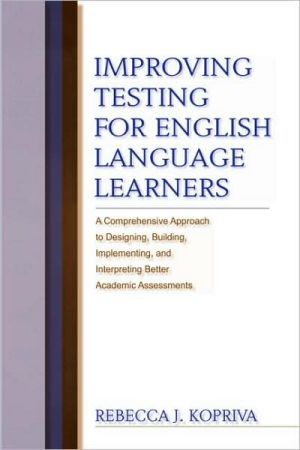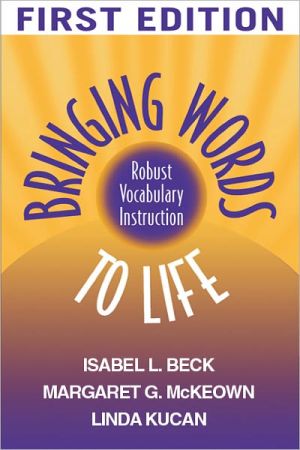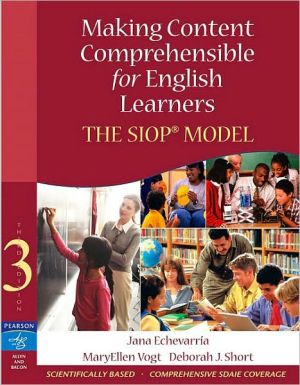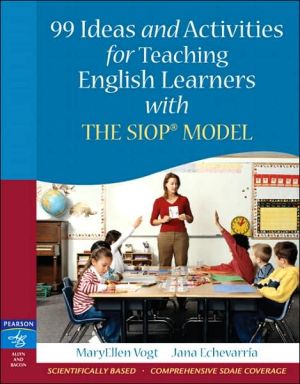Improving Testing Through English Language Learners: A Comprehensive Approach to Designing, Building, Implementing & Interpreting Better Academic Assessments
More than any book to date, this one provides a comprehensive approach to designing, building, implementing and interpreting test results that validly measure the academic achievement of English language learners. It scaffolds the entire process of test development and implementation and discusses essential intervention points. The book provides the type of evidence-based guidance called for in federal mandates such as the NCLB legislation. Key features of this important new book include the...
Search in google:
More than any book to date, this one provides a comprehensive approach to designing, building, implementing and interpreting test results that validly measure the academic achievement of English language learners. It scaffolds the entire process of test development and implementation and discusses essential intervention points. The book provides the type of evidence-based guidance called for in federal mandates such as the NCLB legislation. Key features of this important new book include the following…Comprehensive – This book recommends methods for properly including ELLs throughout the entire test development process, addressing all essential steps from planning, item writing and reviews to analyses and reporting.Breadth and Depth of Coverage– Coverage includes discussion of the key issues, explanations and detailed instructions at each intervention point. Research Focus – All chapters include an extensive review of current research.Emerging Trends – The chapters summarize guidance appropriate for innovative computer-based assessments of the future as well as the paper-and-pencil tests of today.This book is appropriate for anyone concerned with the development and implementation of fair and accurate testing programs for English language learners. This includes university based researchers, testing personel at the federal, state and local levels, teachers interested in better assessing their diverse student populations and those involved in the testing industry. It is also appropriate for instructors teaching undergraduate and graduate courses devoted to testing the full range of students in todays schools.
Preface xiPurpose and Overview 1Changing Demographics in a Testing Culture: Why This Issue Matters 13Demographics and School Policy 14Demographics Snapshot 14An Educational Policy Snapshot 17ELLs: A Heterogeneous Population 19Culture and Learning 20Culture and Assessment 25The Educational Assessment of English Language Learners 29Tests of English Language Proficiency 30Large-scale Academic Achievement Assessments 33The Past as Preparation: Measurement, Public Policy, and Implications for Access 37A Brief History of Large-scale Achievement Testing 37Development of Measurement Theory Models 42Reliability to Multidimensional Item Response Theory 42A Changing View of Test Validity 45Fifty Years of Federal Policy Regarding Equity and the Use of Achievement Testing 50ESEA: Full Inclusion, Disaggregated Reporting, and Beyond 50Other Federal Influences 53Building Assessments to be More Accessible for ELLs 55Conceptual Underpinnings 55Developing Accessible Tests 59Estimating Levels of Access 60Getting Started: Issues of Participation, Alignment, and Validating Access with Test Specifications 65Participation in Test Development 66Expert Participation in Test Development 66Student Participation in Small Sample Pilots and Large Sample Field Tests 67Test Specifications and Content Validity 68Components of Test Specifications 68Documenting Content Validity for English Language Learners: The Access Specifications Package 70Alignment Considerations 73Overview 73Alignment and English Language Learners 76Providing the Foundation of Principled Test Construction: Maintaining the Integrity of the Item Targets 81Overview 82Overview of Access and Item Development 84The Centrality of Item Targets: Clearly Defining Intended Knowledge and Skills 88Development and Completion of Access-based Item Templates 90Access-based Item Development 101Contextual Factors 105Culturally broad experiences 105Making Expectations Clear and Explicit 108Prior Learning Expectations 110Structural Factors 113Simple Language Structures 114Vocabulary 118Effective Visuals 121Item Format 128Text Amount 132Tools 134Impact of Home Language 135A Note about Rubrics 136Tools, Test Forms, and Reviews 141Tools 141Text Supports 143Manipulatives 145Content-based Resources 147Activities 148Form Considerations 149Choosing Items 150Plain Language Forms 152Computer-based Testing 153L1 Form Considerations 154Using Portfolios 157Reviews 160Internal Reviews 160Fairness Reviews 161Putting It All Together 167In What Language Should English Language Learners Be Tested? 169Defining ELLs 171Variation Among ELLs 171Patterns of Language Proficiency 173Additional Sources of Linguistic Differences 176Limitations of Official Definitions of "ELL" 177Section Summary 179Classifying ELLs 180Schooling Background 180Defining and Assessing Language Proficiency 181Literacy and Academic Language as Part of Language Proficiency 182A Modern View of Language Proficiency: Communicative Competence 183Limitations of Mandated English Language Development Tests 185Section Summary 187Testing ELLs 188Limitations of Testing ELLs in English 189Limitations of Testing ELLs in L1 191Major Challenges in the Selection of Language for Testing ELLs 192Section Summary 194Future Directions 194Local Specificity of Testing Models 195Optimum Number of Items as Testing Accommodation 196Other Relevant Accommodations and Pretest Support 201Promising Administration Accommodations 203Extra Time 203Small Group 204Oral Administration 205Language Liaison 206Promising Response Accommodations 208Written Home Language or Code-switching 209Oral in English, the Home Language, or Code-switching 209Demonstrated or Modeled Response 210Pretest Support 211Classroom Support 212Family Assessment Night 214Proper Assignment of Accommodations to Individual Students 217Key Assignment Considerations 218Student Factors 219Accommodations 225Capacity 227Defining the Task 228Policy-based Approaches 229Research-based Approaches 233Operational and Prototypical Systems 240Guidance Models 241Research-based Standardized Data Collection and Assignment Systems 244Implications 251Scoring Considerations for English Language Learners 255Issues Which Impact Scoring 256Linguistic Considerations Influenced by the Home Language 257Cultural Considerations 262Language Acquisition Issues 268Access-based Scorer Training 271Scoring Process Considerations 274Selected Technical Considerations 279Developing an Interpretable Research Agenda for Documenting Validity 281Validation Design Model 282Research Design Considerations 286Selected Quantitative Approaches 288Modeling Relationships of Variables: Selected Methods 289Modeling Data from Continuous and Categorical Variables 290Modeling Frequency Data from Categorical Variables 295Comparison of Groups and Treatments: Selected Methods 297Comparison of Test Score Level Data 297Differential Item Functioning 298Other Methods for Analyzing Items 304Comparison of Model Structures 305Qualitative Approaches 306Tryouts and Pilots 307Cognitive Labs 308Comparability Considerations 310Defining Comparability 310Analyzing Construct Equivalence 313Analyzing Score Equivalence 316References 319Index 345
\ From the Publisher"This is an important text for those interested in second and foreign language testing and assessment, even though the title emphasizes "English Language Learners." There is much to garner here to improve language test items for all language learners.…[Kopriva’s] text encourages language professionals to participate in test and assessment development with insights, ideas (both procedural and empirical), and debate for the twenty-first century."— Die Unterrichtspraxis/Teaching German, 42.2 (Fall 2009)\ \








